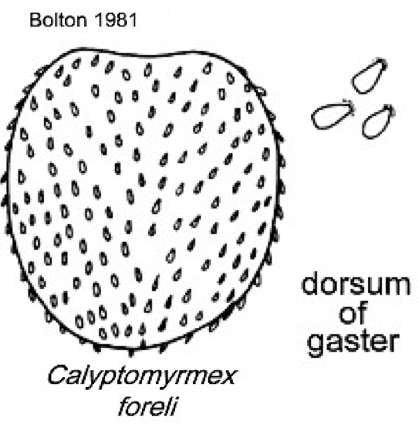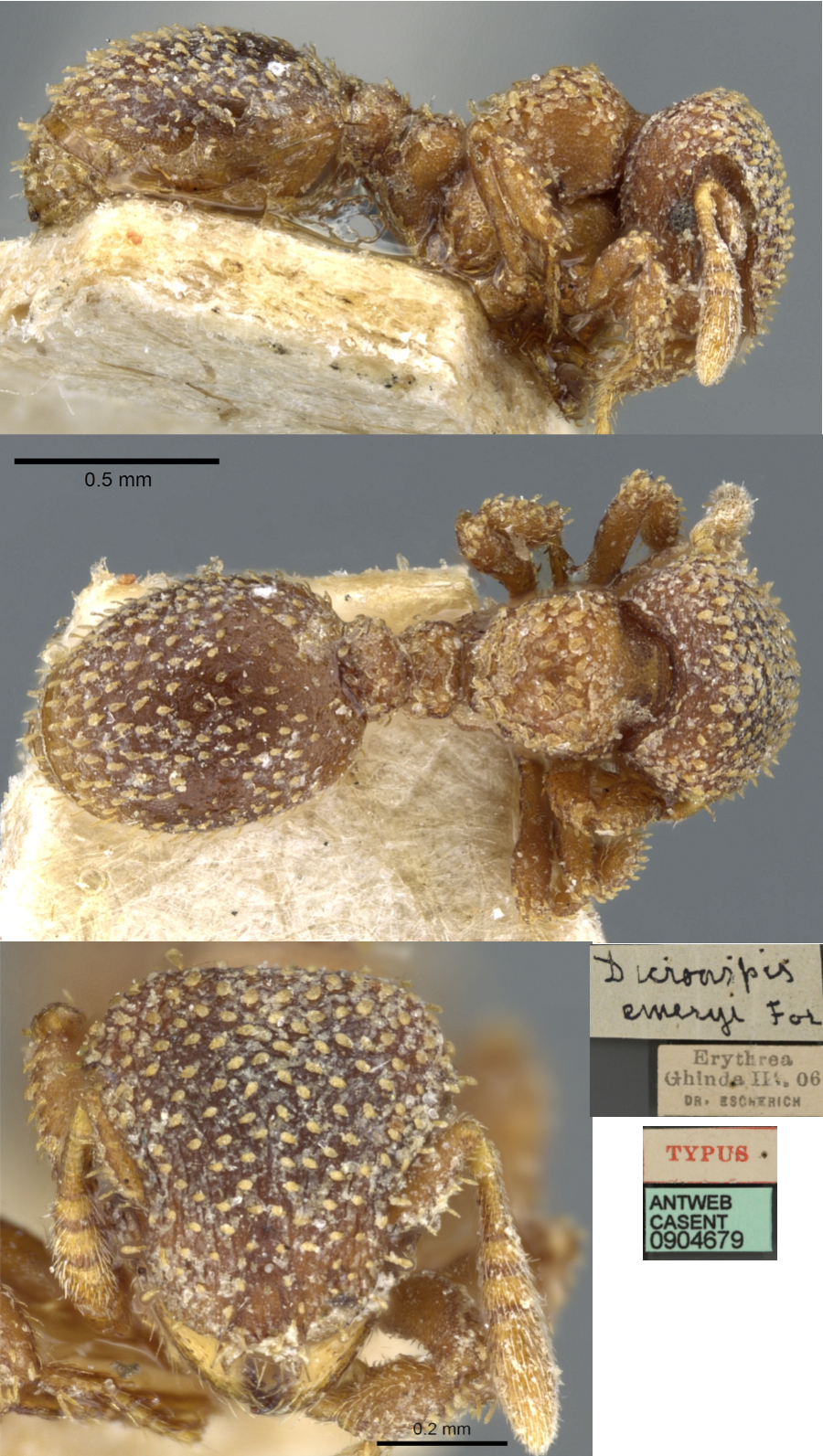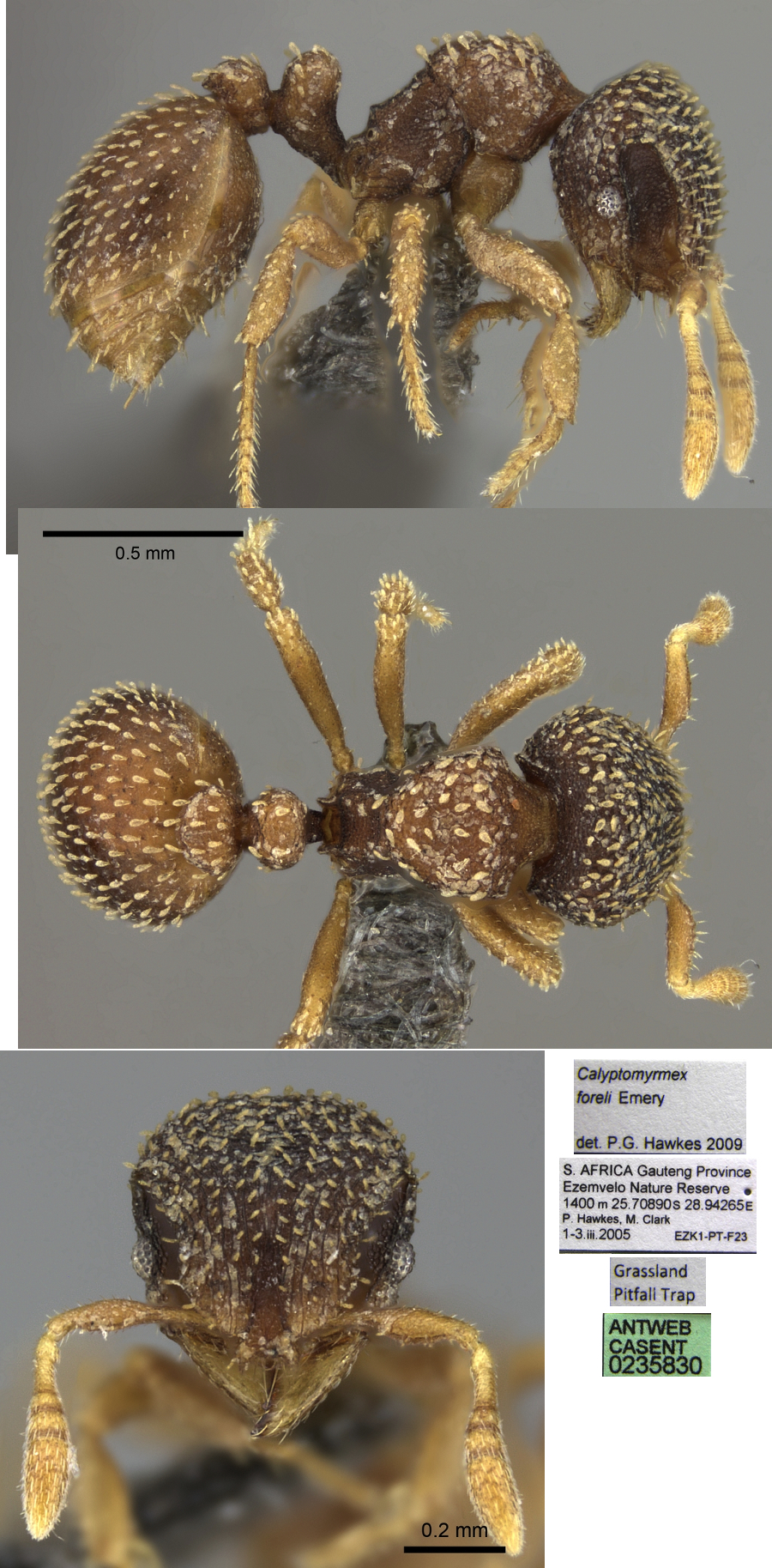Calyptomyrmex foreli Emery
  Type location Eritrea
(Dicroaspis emeryi n. sp., Forel 1910c: 262, worker; Santschi
1913c:
311, queen; type location Ethiopia in Bolton, 1981a) Ghinda;
replacement name foreli
(Emery 1915g: 15) - see below Type location Eritrea
(Dicroaspis emeryi n. sp., Forel 1910c: 262, worker; Santschi
1913c:
311, queen; type location Ethiopia in Bolton, 1981a) Ghinda;
replacement name foreli
(Emery 1915g: 15) - see below
junior synonyms
hartwigi (Calyptomyrmex
Arnoldi Hartwigi n. subsp., Arnold, 1948: 220,
worker & male) from South Africa, Pretoria, E K Hartwig - no images on Antweb (September 2014)
pusillus from Gabon (Calyptomyrmex (Dicroapsis) pusillus,
n. sp., Santschi, 1915c: 256, worker) - see http://www.antweb.org/specimenImages.do?code=casent0913953
All forms
described
(see Bolton, 1981a: 67; Bolton, 1995)  . .
|
 Forel's
(1910c) description is at Forel's
(1910c) description is at  . Santschi's (1913c)
description of the
queen (from Harrar, Ethiopia, collected by Reichensperger, is
at . Santschi's (1913c)
description of the
queen (from Harrar, Ethiopia, collected by Reichensperger, is
at  . Arnold's (1948) description of hartwigi
is at . Arnold's (1948) description of hartwigi
is at  . Bolton's modern
description (1987) is at . Bolton's modern
description (1987) is at 
|
WORKER - TL 2.3-3.0 mm; diagnostic character is presence
of
the roughly triangular area of the vertex with transverse rugae
(Bolton, 1981a, illustrated).
Bolton (1981a) found the distribution pattern - Gabon,
Ethiopia and South Africa "disturbing". I agree and really wonder if
the species is "widely distributed but rare" or if Bolton's synonymy is
incorrect, with pusillus as a species in its own right (it was
listed as such by Wheeler, 1922).
|
 The
photomontage of the type worker
is collated from http://www.antweb.org/specimen.do?name=casent09046790 The
photomontage of the type worker
is collated from http://www.antweb.org/specimen.do?name=casent09046790
|
 The
photomontage of a worker, from South Africa
is collated from http://www.antweb.org/specimen.do?name=casent0235830 The
photomontage of a worker, from South Africa
is collated from http://www.antweb.org/specimen.do?name=casent0235830
|
Santschi's (1915c) description of pusillus is -
TL 1.9-2. Head distinctly longer than wide; posterior border slightly
convex and with rounded angles. Eyes convex, with 15-17 facets; set in
the posterior third of the inferior border of the scrobe. Frontal area
an elongated shiny triangle. Clypeus with a scalloped anterior edge
with lateral teeth. Frontal carinae scalloped in their posterior half -
allowing the eye to be seen from above when the antenna is extended out
of the scrobe. The scrobe is wide and prolonged notably by the closed
mandibles and the lobe of the clypeus. Mandibles smooth with 5-6 teeth.
Scape dilated in the distal one-third; first segment of the funiculus
slender and as long as the four succeeding segments together. Pronotum
with right-angled shoulder; anterior border somewhat convex, lateral
edges converging posteriorly but ill-defined. Promesonotal suture
ill-defined but indicated on the sides by a small notch. Mesonotum
strongly bordered and dropping a little before the propodeal dorsum;
latter feebly convex, longer than the declivity, with the angles marked
by a small indistinct tubercle. Pedicel nodes subequal seen from above,
postpetiole a little wider and longer, both twice as wide as long. In
profile the petiole node is as high as it is long; postpetiole node is
slightly lower, equally rounded above and with a ventral tooth. Gaster
truncated anteriorly.
Chestnut brown; occiput, propodeum and gaster brown black; appendages
testaceous red. Matt; posterior and lateral gaster shiny; slightly less
grossly striate than foreli (emeryi). Striations
longitudinal on the front of the head and transverse posteriorly; and
indifferently oblique on the pronotum; intervals with tiny moderately
deep and shiny punctures. Propodeum, sides of thorax and pedicel with
strong, dense and regular puncturation. Ventral and basal gaster finely
reticulo-punctate. Pilosity claviform and yellowish, quite uniform,
save on the head and femora where they are shorter and on the gaster
and thorax where they are less spaced; on the thorax the hairs are in 5
transverse ranges. Seven to nine short silky, subclavate hairs fringe
the edge of the scrobe and the last two gastral segments; also a little
pubescence.
A single specimen came from Gabon, collected by F. Faure.
|
|